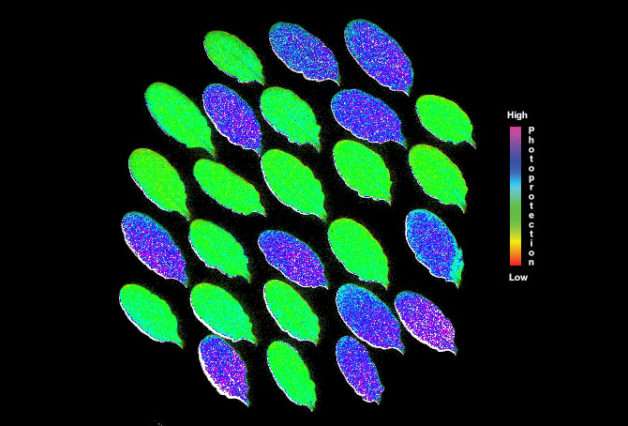Newly discovered algal enzyme could help improve efficiency of photosynthesis and boost crop productivity

For plants and algae that carry on photosynthesis, light can be too much of a good thing. On a bright, sunny day, a plant might only be able to utilize 20 percent or less of absorbed sunlight. The plant dissipates the excess light energy to prevent damage and oxidative stress, and a process called the xanthophyll cycle helps to flip the switch between energy dissipation and energy utilization.
But what if there were a way to tweak that cycle without harming the plant? Berkeley Lab plant biologists are asking that question in an effort to tap into that extra light energy to improve plant growth.
"By manipulating photoprotection in plants, it may be possible to improve the efficiency of photosynthesis, and one potential outgrowth of that is higher crop productivity," said Krishna Niyogi, a faculty scientist in Berkeley Lab's Division of Molecular Biophysics and Integrative Bioimaging and a UC Berkeley professor of plant and microbial biology. "This is a relatively new and underappreciated area of exploration when it comes to understanding and improving photosynthesis."
The xanthophyll cycle involves the synthesis of a pigment called zeaxanthin – an antioxidant that gives corn its yellow color – from another pigment called violaxanthin. Violaxanthin de-epoxidase (VDE) is the key enzyme responsible for this process, which kicks into gear in the presence of excess light.
Niyogi and a postdoctoral researcher in his lab, Zhirong Li, recently identified a target in the photoprotection mechanism by studying the unicellular green alga Chlamydomonas reinhardtii, which is widely used as a model organism to study photosynthesis. The alga produced an enzyme called Chlorophycean VDE (CVDE) that was completely different from the other plant enzymes in the xanthophyll cycle.
To confirm whether this new enzyme performed the same role as the other xanthophyll enzymes, the researchers inserted the CVDE gene into mutant forms of algae and plants that do not produce zeaxanthin. They found that this CVDE enzyme successfully restored the photoprotective abilities of the algae and plants.
Notably, the CVDE protein in the algae is located in a completely different area of the cell – the stromal side of the thylakoid membrane – than its counterpart in plants. By analyzing its evolutionary history, the researchers found that CVDE most likely evolved from an ancient enzyme that was present in the common ancestor of green algae and plants.
"There is about 700 million years or more of evolutionary separation between the green algae group we studied and land plants," said Li. "Despite this, the atypical CVDE protein we identified performs the same photoprotective function. This means that it may be possible to mix and match the regulatory components of light harvesting from different clades of photosynthetic organisms to fine-tune the efficiency of photosynthesis."
The researchers said the CVDE enzyme could be used to optimize photoprotection and thereby improve photosynthesis and crop productivity.
More information: Zhirong Li et al. Evolution of an atypical de-epoxidase for photoprotection in the green lineage, Nature Plants (2016). DOI: 10.1038/nplants.2016.140
Journal information: Nature Plants
Provided by Lawrence Berkeley National Laboratory





















